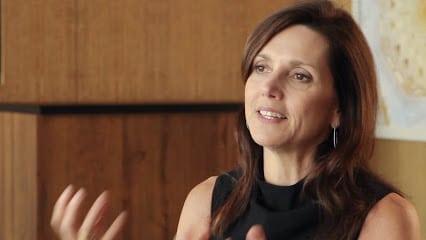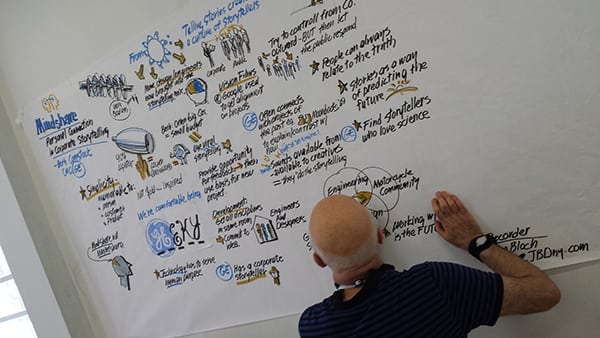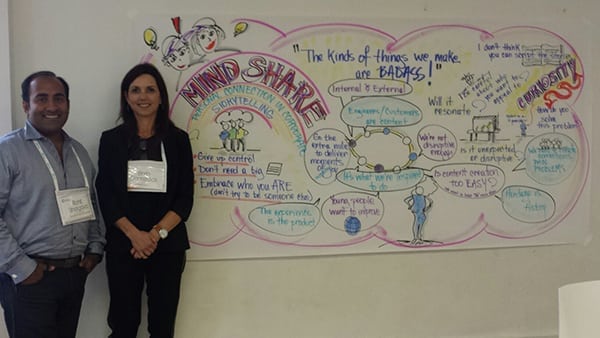I heard the same story three times in a row yesterday, and it was illuminating.
Every year outside the well scripted confines of Manhattan an epic event called The Future of Storytelling brings together designers, technologists, builders and brand marketers to ask the most fundamental question facing any creator: how do you tell a story that people will care about? This year’s event gathered spoken word poets, a master perfumer, a world renowned magician and many other unexpected characters to discuss and question the future of the art of storytelling itself.
At an event like this, injecting a conversation about “corporate storytelling” might seem a bit unambitious. After all, how interesting could marketing be when you are literally following a presentation about the first human in history who is aiming to actually become a cyborg by implanting an antennae in his brain that allows him to “hear colors.”
Yet I was lucky to this exact challenge with perhaps the one person in the world of marketing and business who could best do it, General Electric CMO Beth Comstock. Over the course of three hour long moderated roundtable discussions with about 25 people per session, we debated everything from how brands might work with creators to why so much of “content marketing” is so tragically forgettable.
Over the course of those three hours – here were some of the most powerful insights that arose from our collaborative discussion around how any brand might best use corporate storytelling to make a lasting emotional connection with the audiences they care about:
1. Develop “Story Archaeologists.”
The brilliant thing about archaeologists is that they don’t create history, they only discover it and help us find the meaning behind it. Similarly, there are so many stories that brands have already behind the way they make the things they make. If you can simply get better at finding them more consistently, you can often unlock a hidden treasure of stories that are waiting to be shared.
2. Be A Participant, Not A Patron.
We expect a certain behaviour of our patrons – particularly when it comes to the Arts. The most obvious way for a brand to support a story is simply to sponsor it. Yet slapping a “Presented by” logo on a piece of storytelling produced by someone else is never the same as true storytelling. Instead, great storytelling requires you to be a participant and take a leap of faith to produce something.
3. Make The Invisible Visible.
When you make big intimidating world shifting products like a jet engine – it can be easy for the individuals behind it to lose their sense of purpose. The end product is often invisible to them. Yet if you can bring that engineer to the first flight of the aircraft using that engine, or connect the designer of the new MRI machine to the cancer patient who ends up using it then you can make the impact of what they do come to life. Those situations create amazing stories because you make the invisible impact of their work visible.
4. Hire People Who Are “Story Culture” Fits.
All storytellers are not created equal and the thing that separates them is passion. A great storyteller for GE must also love science and have curiosity. Without that combination of passion and curiosity, the beauty of the stories that GE might authentically tell could be lost. Great and visual storytelling isn’t about hiring the hottest agency to reshape an image and to make a brand “cool.” Instead, it’s about embracing the inner geek and being true to yourself.
5. Create Wearable Meaning.
The thing that connects people is other people. We tend to think about meaning sometimes in the same way as logic. It has meaning as long as it makes sense. But they are not the same. When a story has true meaning, you connect with it so authentically that you would literally wear it. You would produce a t-shirt, put it on, and never take it off. Perhaps the biggest opportunity for corporate storytelling is to create and evangelize this type of meaning.
The Bottom Line:
Of course, over the span of the day our conversation branched into many different categories and the participants (who I am in the process of curating to list here) offered many other useful ideas. Ultimately, as one participant put it, the key for corporate or brand storytellers is to move beyond history to heritage – because a history is just a list. A heritage is something you can be proud of – and that is worth finding a way to share because people will connect with it and learn from it. Even if they end up hearing it three times in a row. If you enjoyed this, you might also like my article on why “7 Reasons Why GE Is The Most Strategic Brand On Social Media” …









WE RECENTLY REMOVED COMMENTING - LEARN WHY HERE >